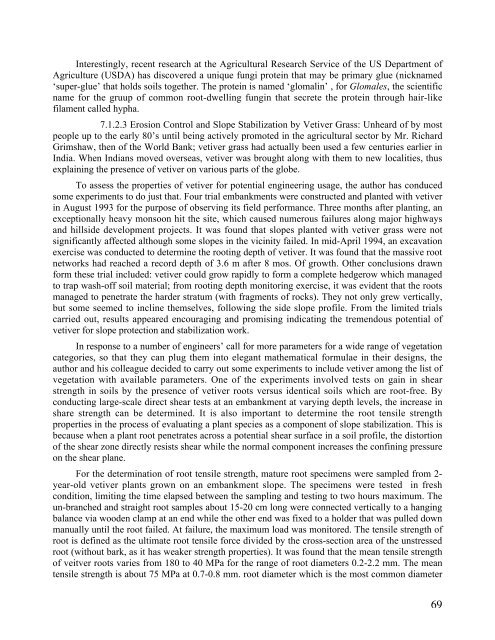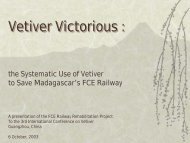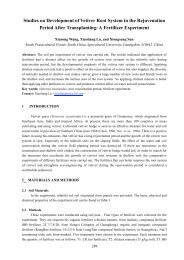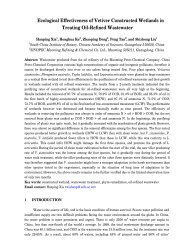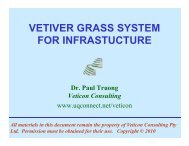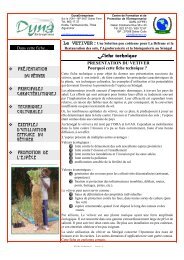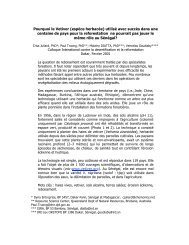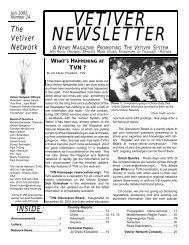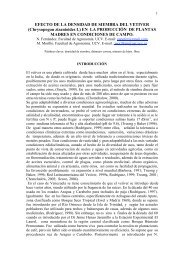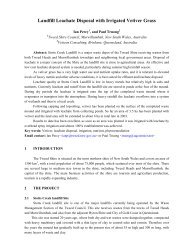Training manual - The Vetiver Network International
Training manual - The Vetiver Network International
Training manual - The Vetiver Network International
Create successful ePaper yourself
Turn your PDF publications into a flip-book with our unique Google optimized e-Paper software.
Interestingly, recent research at the Agricultural Research Service of the US Department of<br />
Agriculture (USDA) has discovered a unique fungi protein that may be primary glue (nicknamed<br />
‘super-glue’ that holds soils together. <strong>The</strong> protein is named ‘glomalin’ , for Glomales, the scientific<br />
name for the gruup of common root-dwelling fungin that secrete the protein through hair-like<br />
filament called hypha.<br />
7.1.2.3 Erosion Control and Slope Stabilization by <strong>Vetiver</strong> Grass: Unheard of by most<br />
people up to the early 80’s until being actively promoted in the agricultural sector by Mr. Richard<br />
Grimshaw, then of the World Bank; vetiver grass had actually been used a few centuries earlier in<br />
India. When Indians moved overseas, vetiver was brought along with them to new localities, thus<br />
explaining the presence of vetiver on various parts of the globe.<br />
To assess the properties of vetiver for potential engineering usage, the author has conduced<br />
some experiments to do just that. Four trial embankments were constructed and planted with vetiver<br />
in August 1993 for the purpose of observing its field performance. Three months after planting, an<br />
exceptionally heavy monsoon hit the site, which caused numerous failures along major highways<br />
and hillside development projects. It was found that slopes planted with vetiver grass were not<br />
significantly affected although some slopes in the vicinity failed. In mid-April 1994, an excavation<br />
exercise was conducted to determine the rooting depth of vetiver. It was found that the massive root<br />
networks had reached a record depth of 3.6 m after 8 mos. Of growth. Other conclusions drawn<br />
form these trial included: vetiver could grow rapidly to form a complete hedgerow which managed<br />
to trap wash-off soil material; from rooting depth monitoring exercise, it was evident that the roots<br />
managed to penetrate the harder stratum (with fragments of rocks). <strong>The</strong>y not only grew vertically,<br />
but some seemed to incline themselves, following the side slope profile. From the limited trials<br />
carried out, results appeared encouraging and promising indicating the tremendous potential of<br />
vetiver for slope protection and stabilization work.<br />
In response to a number of engineers’ call for more parameters for a wide range of vegetation<br />
categories, so that they can plug them into elegant mathematical formulae in their designs, the<br />
author and his colleague decided to carry out some experiments to include vetiver among the list of<br />
vegetation with available parameters. One of the experiments involved tests on gain in shear<br />
strength in soils by the presence of vetiver roots versus identical soils which are root-free. By<br />
conducting large-scale direct shear tests at an embankment at varying depth levels, the increase in<br />
share strength can be determined. It is also important to determine the root tensile strength<br />
properties in the process of evaluating a plant species as a component of slope stabilization. This is<br />
because when a plant root penetrates across a potential shear surface in a soil profile, the distortion<br />
of the shear zone directly resists shear while the normal component increases the confining pressure<br />
on the shear plane.<br />
For the determination of root tensile strength, mature root specimens were sampled from 2year-old<br />
vetiver plants grown on an embankment slope. <strong>The</strong> specimens were tested in fresh<br />
condition, limiting the time elapsed between the sampling and testing to two hours maximum. <strong>The</strong><br />
un-branched and straight root samples about 15-20 cm long were connected vertically to a hanging<br />
balance via wooden clamp at an end while the other end was fixed to a holder that was pulled down<br />
<strong>manual</strong>ly until the root failed. At failure, the maximum load was monitored. <strong>The</strong> tensile strength of<br />
root is defined as the ultimate root tensile force divided by the cross-section area of the unstressed<br />
root (without bark, as it has weaker strength properties). It was found that the mean tensile strength<br />
of veitver roots varies from 180 to 40 MPa for the range of root diameters 0.2-2.2 mm. <strong>The</strong> mean<br />
tensile strength is about 75 MPa at 0.7-0.8 mm. root diameter which is the most common diameter<br />
69


